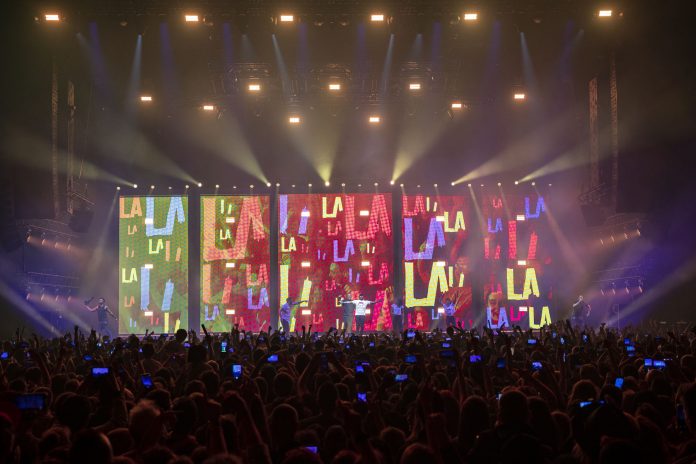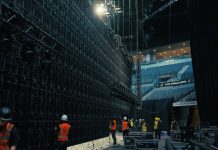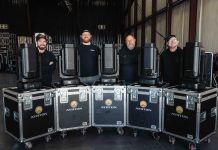Saïd M’Roumbaba – Soprano to his numerous fans – has perfected the art of combining music, politics and urban poetry with edginess, meaning, accessibility and superlative showmanship. His live shows are selling out everywhere, and he is currently touring French-speaking Europe for the rest of the year.
Young French rising star LD Victorien Cayzeele is an integral part of the creative team bringing the Phoenix touring show to life, a task he is doing spectacularly with the help of around 150 Robe moving lights which are at the core of an innovative and emotive visual experience.
Cayzeele has worked with the artist for six years, each tour seeing the shows getting bigger and bigger as Soprano’s influence and popularity grows. The 2019 touring schedule is action packed with a mix of own shows – including 5 stadiums in September – and festival headline slots as well as over 40 arena gigs.
Soprano’s reputation as a live performer and the special connection he has with audiences is also fuelling the incredible demand for concerts. Only seeing him live can really illustrate the power and compulsive charisma that keeps everyone enrapt.
Designing lighting for the Phoenix tour has been a real ‘brain teaser’ for Cayzeele. Working in close collaboration with set designer and Soprano creative director Julien Mairesse, video was always going to be a massive element.
When they decided on five large moving and tracking 10 mm mesh LED screens with 80% transparency as the essential digital scenery and stage architecture, this presented some unique challenges for Cayzeele’s fertile imagination.
The all-axes tracking system – up / down, onstage / offstage and left and right – meant a roof filled with tracking trolleys and motors.
Additionally, an automated 9m long by 2m wide runway flies in from the ceiling – downstage of the tracking screens – for one section of the show. This flies up and down and tilts while Soprano and some of his dancers are performing on it!
So right from the off, Cayzeele had to be simultaneously pragmatic, ingenious and creative – as all the traditional over-stage truss flying positions were taken up with the video screen and the tracking and flying for that and the catwalk.
He also knew early on that he would be looking for small, compact, neat fixtures that gave maximum flexibility for the size. He loves working with Robe products-there is an excellent range of smaller and highly versatile luminaires-so that’s where he looked for the main moving lights.
Before he’d even drawn light on the plot, the team went through a series of essential screen moves and plotted each song in terms of the stage dynamics. … which then dictated the exact positioning of the automation components.
“It was a very exciting and inspirational way to work” said Cayzeele, who enjoys being part of a creative team and the vibrant workflow that results from this scenario, with everyone bouncing ideas and synergies.
Once the tracking hardware was sorted, the lighting trusses were positioned, comprising seven small 2.4m runs squeezed into the gaps with a slight asymmetry, plus two trusses at 7m long, complete with a more regular 20-metre-wide front truss.
Along each side of the stage are three 5-metre trusses hung underneath each other at different heights which provide the main lighting positions. They work well in getting cross stage lighting into the main performance area, which Soprano works extensively –and hyperactively –throughout.
The total Robe counts are 55 Spiider LED wash beams, 14 BMFL Blades, 56 LEDBeam 150s, 26 MegaPointes and four BMFL Spots which are part of a RoboSpot system.
Twenty-four of the Spiiders are on the six side trusses, four per truss.
Some of the LEDBeam 150s are integrated into the video wall, along with the top frames mounted on special brackets, together with some strobes and moving LED battens.
Each of the seven small trusses were loaded with a BMFL Blade, a Spiider, a MegaPointe and a strobe, the larger fixtures on the front rail of the truss and the smaller ones on the back, some of these clearing the tracking trusses by just millimetres – all credit to Dushow’s fantastic rigging crew!
The front truss is loaded with four of the BMFL Blades, four BMFL Spotsand MotionCameras being controlled by three RoboSpot BaseStations, eightMegaPointes, eight Spiiders and six LED strobes.
Cayzeele needs a certain amount of general front light to cover the dancers and any guest vocalists, so the fixtures were all chosen for their multi-functionality. They are also used to highlight the audience for the many interactive parts of the show as Soprano captivates the crowds.
Upstage on the floor is a line of 18 moving LED battens and 6 MegaPointes. There are more LEDBeam 150s in ‘planter’ cases along the front of the stage and more moving LED battens on the top step of the set.
Behind the video screens is a scaffolding structure which houses the DJ and the multi-instrumentalist who are backing Soprano on level two, with additional fixtures rigged on the structure to light them. (The central video wall of the five is ground supported – only the four side pieces and roof fly / track)
The 4 BMFL follow spots are controlled via three RoboSpot BaseStations located side stage. Cayzeele loves these for the “discreet and dynamic” spotting opportunities. “It’s vital to control the physical size of the spot as tightly as possible, especially when there’s a large LED wall onstage, you can’t have light bleeding out around him. Utilising a RoboSpot system gives me this option to literally pinpoint the artists, backing singers and any guests precisely” he commented.
Cayzeele has control over the dimmer, while the operators have focus, iris, pan and tilt. He also comments that ‘sharing’ these parameters between them was a process that evolved very naturally as they built the show during production rehearsals.
He used Spiiders on the last Soprano tour and appreciates the small size, the rich colours, the speed and the fantastic pixel mapping capabilities.
LEDBeam 150s he’s also used before, but on Phoenix they needed some small, bright LED fixtures that were also light enough to be secured onto the LED wall without having a significant impact on the weight loadings.
“At 4kg and super-quick, it was my perfect fixture for this task” he declared.
BMFLs have been a regular choice for different recent projects and he decided to have the Blades and Spots on this for contrasting lightsources (to the LED beams and Spiiders) and to initiate all the BIG statement beamy effects that BMFLs do so well.
Admitting that the MegaPointes are “slightly under-used” as effects – he is not a big lover of gobos or more conventional looks for that matter – they play a key role in the big, fluid sweeping looks that grace the stage during epic moments.
Soprano had originally asked Cayzeele to work with him because of his fresh and different approach to design and his ability to think ‘out-of-the-box’. His work generally has gained traction for being pleasantly free of the ‘lighting clichés’.
Soprano is fully involved in his production and live show presentations.
He is equally as passionate as the creative team around him when it comes to aesthetics and sounds. He likes the show to be theatrical with multiple layers that are revealed to the audience as the journey progresses … and the surprises keep coming!
“He also likes everything to be tightly choreographed and is fully prepared to work with the light to get the best dramatic effects” said Cayzeele, “some of the songs are extremely complex and detailed in terms of technical cues and treatments”.
The show lasts nearly two and a half hours and incorporates an energetic array of visual magic; lighting and video work hard to build definite and invigorating live memories for everyone in the room.
Cayzeele programmed the show assisted by lighting colleague Matthieu Patriarca, with a third operator, Romain Fior taking care of the video programming during the prep period and the first month of the tour.
On the road, he runs all the lighting himself utilising a grandMA3 with grandMA2 software which also triggers the playback video cues – via the SMODE server – through the console. Around 70% of the show is run from timecode from DJ Majide Mazari’sAbletonsessionwhich shares the signals for video, lighting and automation.
All the lighting and audio – a d&b GSL system – is supplied from Dushow, and the video is delivered by one of their partner companies, Alabama. The impressive video content was created by Paris based Cutback Live and automation comes from Canadian company Show Distribution via MASH, also part of the Dushow group.
The IMAG camera mix is being cut by Romain Fortune and the production manager is Pascal Meley who, together with technical director Aymeric Sorriaux, is keeping everything in order on the road.
Cayzeele heaps credit on their amazing lighting and video crew who help it all happen for every gig – so that is chief LX Sebastien Casaban, lighting techs Pierrick Leblanc and Martial Blond, video / lighting tech Lionnel Mulet and video techs Jonas Bergot andMichael Souvy.






